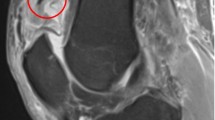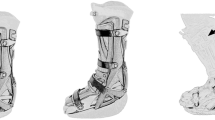Abstract
Purpose
Early functional rehabilitation after surgical tendon repair facilitates the healing process and leads to improved joint function. There is a paucity of studies commenting on rehabilitation after surgical repair of ruptured quadriceps tendons, and most surgeons prefer a prolonged period of immobilization and protected weight bearing. The purpose of the present study is to compare the clinical outcome after a more functional and after a rather restrictive postoperative rehabilitation protocol.
Methods
All consecutive patients were included who had a surgical repair of a primary unilateral quadriceps tendon rupture in one of the two participating hospitals and a minimum follow-up of 24 months. Patients of site A were only allowed limited flexion and weight bearing while patients from site B were allowed early functional rehabilitation with full weight bearing. Clinical outcome was measured with the subjective IKDC form. Fisher’s exact test and Mann–Whitney U test were used for statistical analysis.
Results
Sixty-six patients were included in the study. Twenty-eight patients (Group A) were treated with restrictive and 38 patients (Group B) with early functional postoperative rehabilitation. The two groups did not differ in terms of demographic characteristics. Clinical follow-up was available for 95% of patients after an average of 4.5 years. No clinical difference was identified with the use of IKDC form. Patients of group A returned to work an average of 10 days later than patients from group B, but this difference was not significant. Two re-ruptures were observed in each group. There was no significant difference in terms of complication quality or quantity.
Conclusion
Early functional postoperative mobilization with full weight bearing after primary repair of a quadriceps tendon rupture is safe and will not lead to inferior clinical outcome or an increased complication rate.
Level of evidence
Therapeutic, III.
Similar content being viewed by others
References
Frank CB, Jackson DW (1997) The science of reconstruction of the anterior cruciate ligament. J Bone Jt Surg Am 79:1556–1576
Hak DJ, Sanchez A, Trobisch P (2010) Quadriceps tendon injuries. Orthopedics 33:40–46
Kannus P, Jósza L (1991) Histopathological changes preceding spontaneous rupture of a tendon. A controlled study of 891 patients. J Bone Jt Surg Am 73:1507–1525
Konrath GA, Chen D, Lock T, Goitz HT, Watson JT, Moed BR, D’Ambrosio G (1998) Outcomes following repair of quadriceps tendon ruptures. J Orthop Trauma 12:273–279
Koo SS, Parsley BK, Burkhart SS, Schoolfield JD (2011) Reduction of postoperative stiffness after arthroscopic rotator cuff repair: results of a customized physical therapy regimen based on risk factors for stiffness. Arthroscopy 27:155–160
Langenhan R, Trobisch P, Ricart P, Probst A (2012) Aggressive surgical treatment of periprosthetic femur fractures can reduce mortality: comparison of open reduction and internal fixation versus a modular prothesis nail. J Orthop Trauma 26:80–85
O’Shea K, Kenny P, Donovan J, Condon F, McElwain JP (2002) Outcomes following quadriceps tendon ruptures. Injury 33:257–260
Palmes D, Spiegel HU, Schneider TO, Langer M, Stratmann U, Budny T, Probst A (2002) Achilles tendon healing: long-term biomechanical effects of postoperative mobilization and immobilization in a new mouse model. J Orthop Res 20:939–946
Peltz CD, Dourte LM, Kuntz AF, Sarver JJ, Kim SY, Williams GR, Soslowsky LJ (2009) The effect of postoperative passive motion on rotator cuff healing in a rat model. J Bone Jt Surg Am 91:2421–2429
Trobisch PD, Baumann M, Weise K, Fischer R (2010) Rupture of the quadriceps tendon after lateral retinaculum release by arthroscopy. Unfallchirurg 113:501–503
Trobisch PD, Bauman M, Weise K, Stuby F, Hak DJ (2010) Histologic analysis of ruptured quadriceps tendons. Knee Surg Sports Traumatol Arthroscop 18:85–88
Wenzl ME, Kirchner R, Seide K, Strametz S, Jürgens C (2004) Quadriceps tendon ruptures—Is there a complete functional restitution? Injury 35:922–926
West JL, Keene JS, Kaplan LD (2008) Early motion after quadriceps and patellar tendon repairs: outcomes with single-suture augmentation. Am J Sports Med 36:316–323
Woo SL, Gelberman RH, Cobb NG, Amiel D, Lothringer K, Akeson WH (1981) The importance of controlled passive mobilization on flexor tendon healing. A biomechanical study. Acta Orthop Scand 52:615–622
Acknowledgments
We acknowledge Ashley Pajak from the Hospital for Joint Diseases at New York University, 301 East 17th Street, New York, NY 10003 for her input into the statistical analysis of our data.
Conflict of interest
None.
Author information
Authors and Affiliations
Corresponding author
Additional information
Ronny Langenhan and Matthias Baumann have contributed equally.
Data obtained from Hegau-Bodensee-Klinikum Singen, Germany; and BG Unfallklinik Tübingen, Germany.
This study was approved by the local ethics committee.
Rights and permissions
About this article
Cite this article
Langenhan, R., Baumann, M., Ricart, P. et al. Postoperative functional rehabilitation after repair of quadriceps tendon ruptures: a comparison of two different protocols. Knee Surg Sports Traumatol Arthrosc 20, 2275–2278 (2012). https://doi.org/10.1007/s00167-012-1887-8
Received:
Accepted:
Published:
Issue Date:
DOI: https://doi.org/10.1007/s00167-012-1887-8




